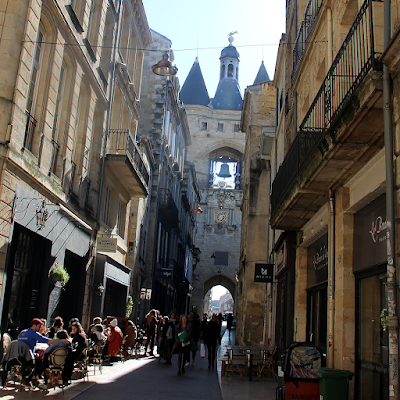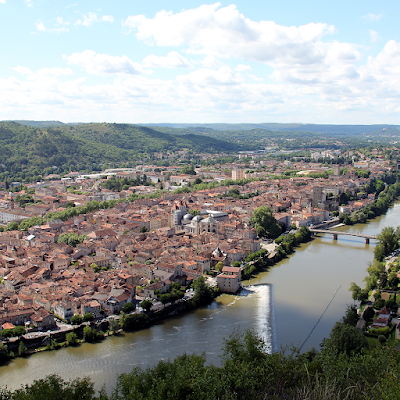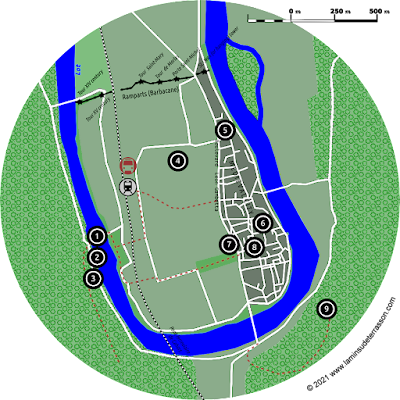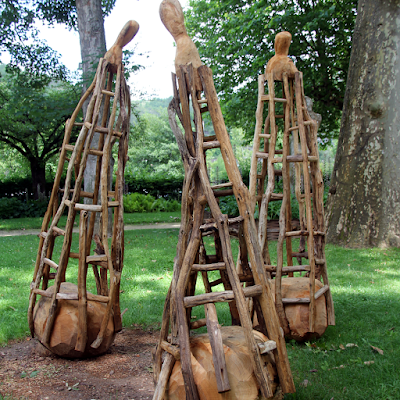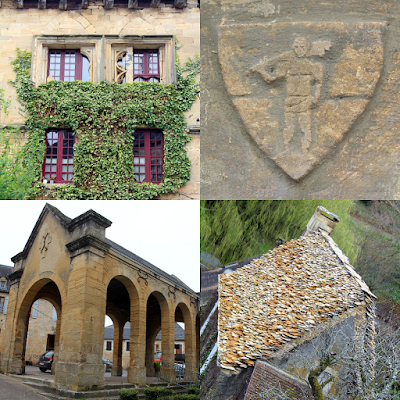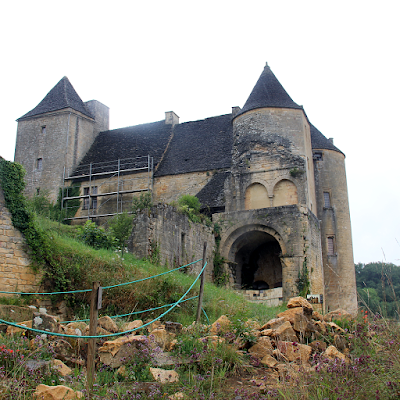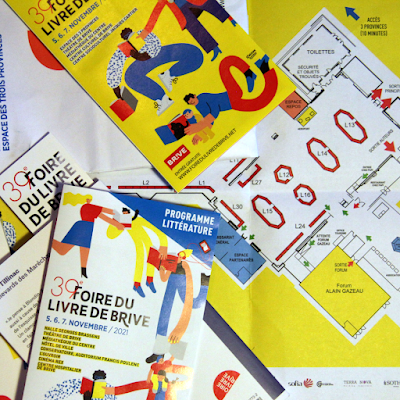 |
| Tulle is above all a city of civil servants, the train station. |
‘Les gens de T(ulle) disent que’on pleure en y arrivant, et qu’on pleure en la
quittant. C’est vrai pour beaucoup de fonctionnaires. Ils sont nommés à T(ulle)…’*
‘Tulle is above all a city of civil servants’ observed Denis Tillinac in his book: Spleen en Corrèze (1979). And ‘...must
have many resources to make itself loved by the civil servant - because the civil servant, fundamentally, necessarily, is a stateless
person, member of the great International of the bureaucracy …’. To understand, and appreciate, Tulle you have to accept it is a
departmental capital that is essentially governed by ‘Paris’ and for-fills the responsibilities of the state.
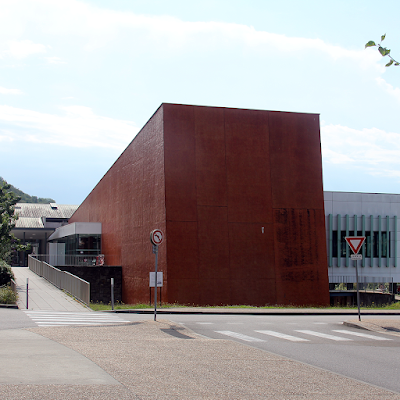 |
|
The modern ‘Médiathèque Intercommunale Eric Rohmer’.
|
It receives tasks,
responsibilities and budgets that have to be implemented by qualified
civil servants living in what they perceive as an exile. An exile
in space and time, ‘... it deprives me of the rhythm of
contemporary life’ wrote Denis. “… Along its murky river…
Tomorrow will be yesterday, and my exile will be like Paradise Lost.’
The ‘perfect place to dream of Paris, or America’, America where
they ‘burn the past like they burn gasoline ... We burn nothing, we
save, we let Time sort out the useful and the useless, the solid and
the inconsistent, the permanent and the ephemeral, certainties and
randomness …’ an important insight walking around Tulle
wondering if there is, at all, a plan to this? (And the short answer
is: ‘No’ ).
 |
|
Tulle is constructed on the banks of the Corrèze river in a narrow
valley.
|
Denis was a
‘localier’, a regional press journalist who does not work at the
headquarters of his newspaper but from a local agency, writing the
‘local pages’ for La Dépêche du Midi. The localier is locally known,
‘when they see us walking down the street with our camera, people
say, "Hey, the journalist from La Gazette. There must be an
accident somewhere."’. I read a few of his books, but reading Spleen en Corrèze made me so curious about Tulle so as to disregard
the general negative advice. And with several direct trains a day connecting
Terrasson and Tulle… what stops me?
 |
| Map of Tulle. |
‘... while attending the inauguration of the new gendarmerie. I met
the usual bunch there: the prefect and the secretary general, the
mayor of Tulle and two deputies, the prosecutor, the president of the
Chamber de Commerce, the Commissioner of General Information… The
same people, and a few others, meet in all the ceremonies, wines of
honor, commemorations, inaugurations. The localiers are also there,
by necessity with a notepad and a camera.’
 |
| Walking up one of the stairs and looking back at the historic center of town. |
Time to take my
notepad and camera and explore Tulle. First impression did not
‘disappoint’, the train station (1) is located at half an hours walk
from the ‘historic center’ and the mismatch of buildings is
impressive. End 1900’s buildings line the street and recall the Belle Époque
when the railroad arrived. The modern Médiathèque
Intercommunale Eric Rohmer looks actually good, some 60s/70s
concrete blocks a little less.
 |
|
‘Cité administrative Jean Montalat’ complete with podium and
pedestrian bridges.
|
Tulle is constructed on the banks of the Corrèze river in a narrow
valley. So space is limited and the shortest routes perpendicular
the river are often stairways up the steep hillside. The
highlight was a huge high-rise Cité administrative Jean Montalat
(9) complete with podium and pedestrian bridges. A city within the city.
It would not raise an eyebrow in any of the new towns on Hong Kong,
but smack in the middle of Tulle…
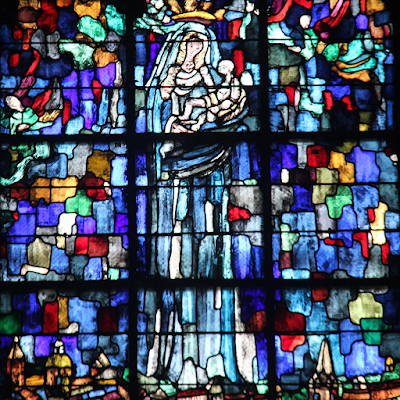 |
|
Cathedral of Notre-Dame de Tulle.
|
Reaching the
historic center we walked the heritage trail that starts at the
Church of Saint Jean (2), towards a cluster of medieval buildings
surrounding the Cathedral of Notre-Dame de Tulle (4) with its cloister.
The cloister museum had an interesting exhibition
‘Poincts en suspension’ by artist Annie Bascoul. The ‘poinct de
Tulle’ (needle-point lace) is a combination of embroidery and its
square ‘fishnet’ knotted mesh support. When the original hand
knotted mesh is used it accentuates the embroidery on a slightly
pecked background.
 |
|
Exhibition ‘Poincts en suspension’ by artist
Annie Bascoul.
|
The exhibition is a
culmination of different projects supported by the city of Tulle
since 2013. Several artists have been invited through residencies to
create unique works that will; ‘bear witness to generations to come
of the fertile dialogue between historical know-how and contemporary
creation’. It was done in collaboration with the Association
Diffusion Renouveau Poinct Tulle a group of friendly ladies who
run a small workshop just next door.
 |
|
14th century frescoes and a central vault with chevron design moldings.
|
Worth a mention are
the Hôtel Lauthonie (3) and the Maison Loyac. We explored the
neighborhood a bit and were surprised to find an (abandoned) Belgium
Consulate. Somewhat surprised I looked for information and found a La
Montagne article** online explaining how a Mr. Vackier had ran a
hardware-store in Tulle since 1906, occupies himself with Belgium
refugees during the first world war and by 1931 received the title of
vice-councilor by royal appointment. By 1940 he found his loyalties
split between king Léopold III’s surrender to Nazi-Germany, and
the Belgium government’s decision to go into exile.
 |
| The (abandoned) Belgium Consulate. |
Here the story gets
an intriguing twist when the Belgium King decides that Tulle,
initially part of non occupied (Vinchy) France, would be a good place
to shelter his three children from the war. So princes (and future
kings) Boudewijn and Albert arrive, together with their sister
princess Charlotte, an aunt of the king finds refuge joining a
religious order in nearby Aubazine. As a thanks for his good care of
the children Mr. Vackier receives the title ‘consul de Belgique à
titre personnel’ in 1946, with jurisdiction over the three
departments of the Limousin. A title he holds-onto till his death in
1962, ‘Portant une fière moustache, bardé de distinctions et
roulant dans les rues de Tulle avec une grosse voiture noire, une
Chambord ou une Versailles dotée de plaques du corps diplomatique.’
 |
| The Church of Saint Pierre. |
The rest of the
heritage trail passes the Church of Saint Pierre (5), the tour d’Alverge
(6) and the municipal Theater (1899) (7) once know as the Théâtre des Sept
Collines in reference to the geography of the town. Looking up the
hillsides you are surrounded by government buildings, schools and
services. A good selection of restaurants in town make it an
interesting day out. I smiled leaving, maybe it was the nice weather,
maybe I left in time...
Find out more about the landscape, history, vegetation, the
villages and life on the causse:
The index of this blog.
*) ‘The people of T(ulle) say that you cry when you get there, and
you cry when you leave. This is true for a lot of public servants.
They are appointed to T(ulle) ... ’
Denis Tillinac (1979): Spleen en Corrèze. Collection <<Les Localiers>> Éditions des autres, 1979. ISBN 2-7305-0031-6
**) Albinet A., 2015. Comment le plus tulliste des Belges a ouvert un consulat dans
sa ville d’adoption ? In: La Montagne, 29/07/2015.



